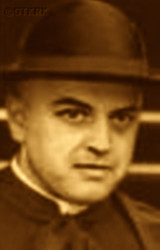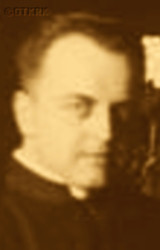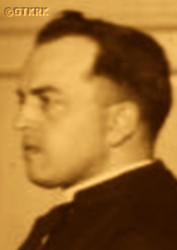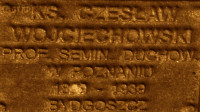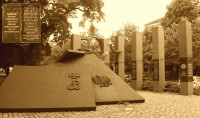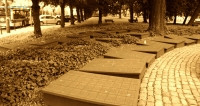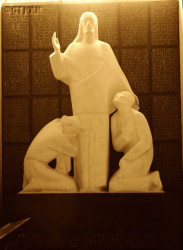Roman Catholic
St Sigismund parish
05-507 Słomczyn
85 Wiślana Str.
Konstancin deanery
Warsaw archdiocese, Poland
full list:
displayClick to display full list

searchClick to search full list by categories
wyświetlKliknij by wyświetlić pełną listę po polsku

szukajKliknij by przeszukać listę wg kategorii po polsku

Martyrology of the clergy — Poland
XX century (1914 – 1989)
personal data
surname
WOJCIECHOWSKI
forename(s)
Ceslav Adalbert (pl. Czesław Wojciech)
function
diocesan priest
creed
Latin (Roman Catholic) Church RCmore on
en.wikipedia.org
[access: 2014.09.21]
diocese / province
Gniezno and Poznań archdiocese (aeque principaliter)more on
www.archpoznan.pl
[access: 2012.11.23]
Polish Catholic Mission in France
academic distinctions
Bachelor of Sacred Theology
date and place
of death
11.11.1939

Bydgoszcztoday: Bydgoszcz city pov., Kuyavia‐Pomerania voiv., Poland
more on
en.wikipedia.org
[access: 2021.06.20]
details of death
After German invasion on 01.09.1939 of Poland (Russians invaded Poland 17 days later) and start of the World War II, after start of German occupation, arrested in 09.1939 by the Germans.
Executed prob. in Bydgoszcz or its nearby forests, in unknown circumstances.
In 1939, Bydgoszcz became a place of particular German repressions. Even before their invasion, the Germans on 03‐04.09.1939 organized a provocation in Bydgoszcz, during which Germ. Volksdeutsche (Eng. Ethnic Germans), i.e. representatives of the German minority in Poland, began shooting Polish soldiers defending Bydgoszcz in the back. The Poles suppressed the rebellion, prob. i.a. by executing many German traitors. The Germans exploited these events for propaganda purposes, calling them the Germ. „Bromberger Blutsonntag” (Eng. „Bydgoszcz Bloody Sunday”). After capturing the city on 05.09.1939, the Germans began bloody repressions against Poles. The Germ. Wehrmacht (Eng. Armed Forces), appointed by the Germ. 4. Armee (Eng. 4th Army), which captured Bydgoszcz, the commander of Bydgoszcz, Major General Walter Braemer, issued on 08.09.1939 an order, to cleanse the city of „criminal Polish elements”. The Germans began searching private homes, apartment by apartment. If weapons, e.g., souvenir sabres, etc., were found, the occupants were shot on the spot. Several public executions were also carried out.
The action was carried out by soldiers of the Germ. Wehrmacht and the genocidal Germ. Einsatzkommando 1/IV (Eng. 1/IV Task Group), part of the Germ. Einsatzgruppen (Eng. Operational Groups), a formation of the Germ. Sicherheitspolizei (Eng. Security Police), i.e. SiPo, and the Germ. Sicherheitsdienst des Reichsführers SS (Eng. Security Service of the Reichsführer SS), i.e. SD, subordinated to the Germ. Reichsicherheitshauptamt (Eng. Reich Main Security Office), i.e. RSHA, operating behind the German 4th Armee.
The repressions then turned into an organized extermination action — as part of the Germ. «Intelligenzaktion» (Eng. Intelligence Action), i.e. the extermination of the Polish intelligentsia and the leadership classes of Pomerania, based on the so‐called Germ. Sonderfahndungsliste (Eng. Special Wanted List), i.e. a proscription list of names of „enemies of the Reich”, prepared before the German aggression, or on some other proscription list, drawn up ad hoc on denunciations from local Germ. Volksdeutsche.
It was carried out by units of the genocidal Germ. Volksdeutscher Selbstschutz (Eng. Ethnic German Self‐Defense), whose members were Germ. Volksdeutsche from Bydgoszcz and the surrounding area, supervised by the paramilitary, genocidal Germ. Die Schutzstaffel der NSDAP (Eng. NSDAP Protection Unit), i.e. «SS», subordinate to the National Socialist German Workers' Party NSDAP, and supported by the Germ. Ordnungspolizei (Eng. Order Police), i.e. OrPo, a formation directly subordinated to the Germ. Chef der Deutschen Polizei (Eng. Chief of the German Police), the genocide master Heinrich Himmler. By the end of 1939, the Germans had murdered c. 5,000 Poles in public and hidden executions — many in nearby forests — including c. 1,500‐1,900 from Bydgoszcz alone.
Arrested Poles, after initial interrogations, were held mainly in the IL Bromberg internment camp, established on the premises of the barracks of the Polish 15th Light Artillery Regiment at 147 Gdańska Street. From there, were transported to the execution site or to concentration camps. In 09.1939 alone, c. 3,500 Poles (approximately 2.5% of Bydgoszcz's Polish residents) passed through the camp.
cause of death
murder
perpetrators
Germans
sites and events
IL BrombergClick to display the description, «Intelligenzaktion»Click to display the description, Reichsgau Danzig‐WestpreußenClick to display the description, Ribbentrop‐MolotovClick to display the description, Pius XI's encyclicalsClick to display the description
date and place
of birth
17.04.1899Birth certification on:
www.genealogiawarchiwach.pl
[access: 2025.09.29]

Strzelnotoday: Strzelno gm., Mogilno pov., Kuyavia‐Pomerania voiv., Poland
more on
en.wikipedia.org
[access: 2021.07.18]
parents
WOJCIECHOWSKI Ignatius
🞲 ?, ? — 🕆 ?, ?

WIETECKA Marianne
🞲 ?, ? — 🕆 ?, ?
presbyter (holy orders)
ordination
15.03.1924

Gnieznotoday: Gniezno urban gm., Gniezno pov., Greater Poland voiv., Poland
more on
en.wikipedia.org
[access: 2021.12.18]
Assumption of the Blessed Virgin Mary RC archcathedral churchmore on
en.wikipedia.org
[access: 2025.03.14]
positions held
1938 – 1939
clerk — Poznańtoday: Poznań city pov., Greater Poland voiv., Poland
more on
en.wikipedia.org
[access: 2021.07.18] ⋄ Personal Chancellery of His Eminence Cardinal Primate of Poland
1938 – 1939
1st secretary — Poznańtoday: Poznań city pov., Greater Poland voiv., Poland
more on
en.wikipedia.org
[access: 2021.07.18] ⋄ Office, Bishops' Ordinariate
till 1939
editor — „Church monthly magazine of the Archdiocese of Gniezno and Poznań”
1934 – 1938
supernumerary professor — Gnieznotoday: Gniezno urban gm., Gniezno pov., Greater Poland voiv., Poland
more on
en.wikipedia.org
[access: 2021.12.18] ⋄ Archbishop's Theological Seminary — philosophy, social ethics, history of philosophy
1932 – 1939
chaplain — Poznańtoday: Poznań city pov., Greater Poland voiv., Poland
more on
en.wikipedia.org
[access: 2021.07.18] ⋄ to August Card. Hlond, the Primate of Poland
c. 1932
chaplain — Pokrzywnotoday: part of Krzesiny‐Pokrzywno‐Garaszewo neighborhood in Poznań, Poznań city pov., Greater Poland voiv., Poland
more on
en.wikipedia.org
[access: 2021.07.18] ⋄ Congregation's house, St Elizabeth Sisters CSSE ⋄ RC chapel (semi–public) ⋄ Spławietoday: part of Szczepankowo‐Spławie‐Krzesinki neighborhood in Poznań, Poznań city pov., Greater Poland voiv., Poland
more on
en.wikipedia.org
[access: 2021.07.18], St Andrew the Apostle RC parish ⋄ Środatoday: Środa Wielkopolska, Środa Wielkopolska gm., Środa Wielkopolska pov., Greater Poland voiv., Poland
more on
en.wikipedia.org
[access: 2021.06.20] RC deanery
from 1931
rector — Poznańtoday: Poznań city pov., Greater Poland voiv., Poland
more on
en.wikipedia.org
[access: 2021.07.18] ⋄ house of philosophy students, Foreign Seminary
1930 – 1931
PhD student — Rometoday: Rome prov., Lazio reg., Italy
more on
en.wikipedia.org
[access: 2021.12.18] ⋄ philosophy — residing at the Polish Pontifical Church Institute on 38 via Pietro Cavallini
from 1927
priest — Tournaitoday: Hainaut prov., Wallonia reg., Belgium
more on
en.wikipedia.org
[access: 2022.11.20] — among Polish emigrants and migrants
1927 – 1930
student — Louvaintoday: Flemish Brabant prov., Flemish reg., Belgium
more on
en.wikipedia.org
[access: 2020.11.07] ⋄ moral philosophy and ethics, Leo XIII Seminary, Université Catholique de Louvain (pl. Catholic University of Leuven) — also: chaplain among Polish emigrants and migrants (n. Tounai in Belgium)
1924 – 1927
vicar — PoznańOstrów Tumski
today: Poznań city pov., Greater Poland voiv., Poland
more on
en.wikipedia.org
[access: 2022.02.03] ⋄ St Peter and St Paul the Apostles RC archcathedral church
till 1924
student — Gnieznotoday: Gniezno urban gm., Gniezno pov., Greater Poland voiv., Poland
more on
en.wikipedia.org
[access: 2021.12.18] ⋄ philosophy and theology, Archbishop's Practical Theological Seminary (Lat. Seminarium Clericorum Practicum)
from 1919
student — Poznańtoday: Poznań city pov., Greater Poland voiv., Poland
more on
en.wikipedia.org
[access: 2021.07.18] ⋄ philosophy and theology, Archbishop's Theological Seminary (Collegium Leoninum)
others related
in death
GRUCHAŁAClick to display biography Edmund, JAKUBOWSKIClick to display biography John, KOŹLIKClick to display biography Stanislav, KUKUŁKAClick to display biography Lucyn, LEWICKIClick to display biography Anthony Severin, ROŻEKClick to display biography Alexander, STEPCZYŃSKIClick to display biography Casimir, SZAREKClick to display biography Peter, WAGNERClick to display biography John Francis, WIOREKClick to display biography Stanislav
sites and events
descriptions
IL Bromberg: Germ. „Internierungslager” (Eng. „Internment camp”) set up on 05.09.1939 — the day Germans took over Bydgoszcz — in 15 Greater Poland Light Artillery Regiment military barracks at 147 Gdańska Str. in Bydgoszcz. In 09.1939 only c. 3,500 Poles were jailed there. Prisoners were held in f. stables or f. armory building. They were maltreated and tortured. Some were shot on the spot (c. 28 victims in 09.1939). Next they were sent to concentration camps throughout Germany. Some were taken to mass execution sites in nearby forests and murdered. On 01.11.1939 the camp was moved to f. ammunition warehouses in Jachcice town district. The camp was closed in 12.1939. (more on: pl.wikipedia.orgClick to attempt to display webpage
[access: 2015.09.30])
«Intelligenzaktion»: German: «Intelligenzaktion» (English: „Intelligence Action”) — a German program of extermination of the Polish elite, mainly the intelligentsia and leadership layers, carried out from the beginning of the occupation in w 09.1939 to 04.1940, mainly in territories directly annexed to Germany, but also in the so‐called Germ. Generalgouvernement (Eng. General Governorate), where it was called «AB‐aktion». In the first phase, immediately after the beginning of the German occupation, during military operations carried out by the Germ. Wehrmacht (Eng. Armed Forces) and the genocidal units of the Germ. Einsatzgruppen (Eng. Operational Groups) of the Germ. Sicherheitspolizei (Eng. Security Police), i.e. SiPo, and Germ. Sicherheitsdienst des Reichsführers SS (Eng. Security Service of the Reichsführer SS), i.e. SD, organized by the Germ. Reichssicherheitshauptamt (Eng. Reich Main Security Office), i.e. RSHA, which followed the troops, carried out under the Germ. Unternehmen „Tannenberg” (Eng. Operation „Tannenberg”) — based on the so‐called Germ. Sonderfahndungsliste (Eng. Special Wanted Lists), i.e. proscription lists of Poles considered particularly dangerous to the Third Reich, prepared by the Zentralstelle II/P (Polen) unit of the German RSHA. Later, implemented by the German civilian occupation authorities and the genocidal unit of the Germ. Volksdeutscher Selbstschutz (Eng. Ethnic Germans Self‐Defense), whose members were Germ. Volksdeutsche (Eng. Ethnic Germans), i.e. representatives of the German minority in Poland. According to various sources, these lists, at the beginning of 09.1939, could have contained the details of 61,000—88,000 „dangerous” Poles — although these figures cannot be confirmed. In total, during this genocide, c. 50,000 teachers, Catholic priests, representatives of the landed gentry, freelancers, social and political activists, and retired military personnel were systematically and methodically murdered. Another 50,000 were sent to concentration camps, where only a negligible percentage survived. (more on: en.wikipedia.orgClick to attempt to display webpage
[access: 2014.10.04])
Reichsgau Danzig‐Westpreußen: After the Polish defeat in the 09.1939 campaign, which was the result of the Ribbentrop‐Molotov Pact and constituted the first stage of World War II, and the beginning of German occupation in part of Poland (in the other, eastern part of Poland, the Russian occupation began), the Germans divided the occupied Polish territory into five main regions (and a few smaller). The largest one was transformed into Germ. Generalgouvernement (Eng. General Governorate), intended exclusively for Poles and Jews and constituting part of the so‐called Germ. Großdeutschland (Eng. Greater Germany). Two were added to existing German provinces. From two other separate new provinces were created. Vistula Pomerania region was one of them, incorporated into Germany on 08.10.1939, by decree of the German leader Adolf Hitler (formally came into force on 26.10.1939), and on 02.11.1939 transformed into the Germ. Reichsgau Danzig‐Westpreußen (Eng. Reich District of Gdańsk‐West Prussia) province, in which the law of the German state was to apply. The main axis of the policy of the new province, the territory of which the Germans recognized as the Germ. „Ursprünglich Deutsche” (Eng. „natively German”), despite the fact that 85% of its inhabitants were Poles, was Germ. „Entpolonisierung” (Eng. „Depolonisation”), i.e. forced Germanization. C. 60,000 Poles were murdered in 1939‐1940, as part of the Germ. „Intelligenzaktion”, i.e. extermination of Polish intelligentsia and ruling classes, in c. 432 places of mass executions — including c. 220 Polish Catholic priests. The same number were sent to German concentration camps, from where few returned (over 300 priests were arrested, of whom c. 130 died in concentration camps). C. 124,000‐170,000 were displaced, including c. 90,000 to the Germ. Generalgouvernement. Poles were forced en masse to sign the German nationality list, the Germ. Deutsche Volksliste DVL. Polish children could only learn in German. It was forbidden to use the Polish language during Catholic Holy Masses and during confession. Polish landed estates were confiscated..To further reduce the number of the Polish population, Poles were sent to forced labor deep inside Germany. The remaining Poles were treated as low‐skilled labor, isolated from the Germans and strictly controlled — legally, three or three of them could only meet together, even in their own apartments. Many were conscripted into the German Wehrmacht army. After the end of hostilities of World War II, the overseer of this province, the Germ. Reichsstatthalter (Eng. Reich Governor) and the Germ. Gauleiter (Eng. district head) of the German National Socialist Party, Albert Maria Forster, was executed. (more on: en.wikipedia.orgClick to attempt to display webpage
[access: 2024.06.24])
Ribbentrop‐Molotov: Genocidal Russian‐German alliance pact between Russian leader Joseph Stalin and German leader Adolf Hitler signed on 23.08.1939 in Moscow by respective foreign ministers, Mr. Vyacheslav Molotov for Russia and Joachim von Ribbentrop for Germany. The pact sanctioned and was the direct cause of joint Russian and German invasion of Poland and the outbreak of the World War II in 09.1939. In a political sense, the pact was an attempt to restore the status quo ante before 1914, with one exception, namely the „commercial” exchange of the so‐called „Kingdom of Poland”, which in 1914 was part of the Russian Empire, fore Eastern Galicia (today's western Ukraine), in 1914 belonging to the Austro‐Hungarian Empire. Galicia, including Lviv, was to be taken over by the Russians, the „Kingdom of Poland” — under the name of the General Governorate — Germany. The resultant „war was one of the greatest calamities and dramas of humanity in history, for two atheistic and anti‐Christian ideologies — national and international socialism — rejected God and His fifth Decalogue commandment: Thou shall not kill!” (Abp Stanislav Gądecki, 01.09.2019). The decisions taken — backed up by the betrayal of the formal allies of Poland, France and Germany, which on 12.09.1939, at a joint conference in Abbeville, decided not to provide aid to attacked Poland and not to take military action against Germany (a clear breach of treaty obligations with Poland) — were on 28.09.1939 slightly altered and made more precise when a treaty on „German‐Russian boundaries and friendship” was agreed by the same murderous signatories. One of its findings was establishment of spheres of influence in Central and Eastern Europe and in consequence IV partition of Poland. In one of its secret annexes agreed, that: „the Signatories will not tolerate on its respective territories any Polish propaganda that affects the territory of the other Side. On their respective territories they will suppress all such propaganda and inform each other of the measures taken to accomplish it”. The agreements resulted in a series of meeting between two genocidal organization representing both sides — German Gestapo and Russian NKVD when coordination of efforts to exterminate Polish intelligentsia and Polish leading classes (in Germany called «Intelligenzaktion», in Russia took the form of Katyń massacres) where discussed. Resulted in deaths of hundreds of thousands of Polish intelligentsia, including thousands of priests presented here, and tens of millions of ordinary people,. The results of this Russian‐German pact lasted till 1989 and are still in evidence even today. (more on: en.wikipedia.orgClick to attempt to display webpage
[access: 2015.09.30])
Pius XI's encyclicals: Facing the creation of two totalitarian systems in Europe, which seemed to compete with each other, though there were more similarities than contradictions between them, Pope Pius XI issued in 03.1937 (within 5 days) two encyclicals. In the „Mit brennender Sorge” (Eng. „With Burning Concern”) published on 14.03.1938, condemned the national socialism prevailing in Germany. The Pope wrote: „Whoever, following the old Germanic‐pre‐Christian beliefs, puts various impersonal fate in the place of a personal God, denies the wisdom of God and Providence […], whoever exalts earthly values: race or nation, or state, or state system, representatives of state power or other fundamental values of human society, […] and makes them the highest standard of all values, including religious ones, and idolizes them, this one […] is far from true faith in God and from a worldview corresponding to such faith”. On 19.03.1937, published „Divini Redemptoris” (Eng. „Divine Redeemer”), in which criticized Russian communism, dialectical materialism and the class struggle theory. The Pope wrote: „Communism deprives man of freedom, and therefore the spiritual basis of all life norms. It deprives the human person of all his dignity and any moral support with which he could resist the onslaught of blind passions […] This is the new gospel that Bolshevik and godless communism preaches as a message of salvation and redemption of humanity”… Pius XI demanded that the established human law be subjected to the natural law of God , recommended the implementation of the ideal of a Christian state and society, and called on Catholics to resist. Two years later, National Socialist Germany and Communist Russia came together and started World War II. (more on: www.vatican.vaClick to attempt to display webpage
[access: 2023.05.28], www.vatican.vaClick to attempt to display webpage
[access: 2023.05.28])
sources
personal:
www.wtg-gniazdo.orgClick to attempt to display webpage
[access: 2012.11.23], www.sacerdospolonus.plClick to attempt to display webpage
[access: 2014.08.14], www.straty.plClick to attempt to display webpage
[access: 2016.03.14], www.genealogiawarchiwach.plClick to attempt to display webpage
[access: 2025.09.29], www.archiwum.archidiecezja.plClick to attempt to display webpage
[access: 2013.08.10], doczz.plClick to attempt to display webpage
[access: 2018.09.02]
original images:
audiovis.nac.gov.plClick to attempt to display webpage
[access: 2016.08.14], audiovis.nac.gov.plClick to attempt to display webpage
[access: 2016.08.14], audiovis.nac.gov.plClick to attempt to display webpage
[access: 2016.08.14]
LETTER to CUSTODIAN/ADMINISTRATOR
If you have an Email client on your communicator/computer — such as Mozilla Thunderbird, Windows Mail or Microsoft Outlook, described at WikipediaPatrz:
en.wikipedia.org, among others — try the link below, please:
LETTER to CUSTODIAN/ADMINISTRATORClick and try to call your own Email client
If however you do not run such a client or the above link is not active please send an email to the Custodian/Administrator using your account — in your customary email/correspondence engine — at the following address:

giving the following as the subject:
MARTYROLOGY: WOJCIECHOWSKI Ceslav Adalbert
To return to the biography press below:
 Click to return to biography
Click to return to biography








